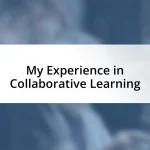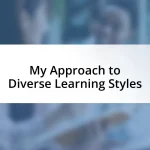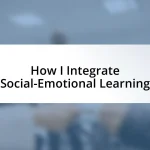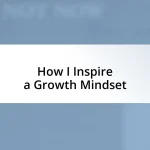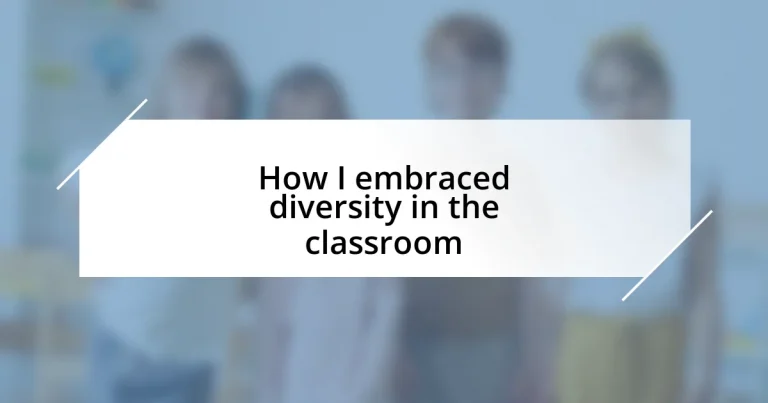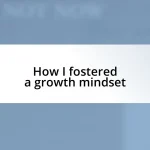Key takeaways:
- Diversity enhances the learning experience by fostering empathy and engagement through shared cultural stories and experiences.
- Recognizing varied learning styles among students allows for tailored teaching methods, promoting inclusivity and academic success.
- Incorporating diverse perspectives in the curriculum, such as multicultural literature and guest speakers, enriches students’ understanding of social issues.
- Encouraging open dialogue and collaborative activities helps build a sense of community and respect among students from different backgrounds.
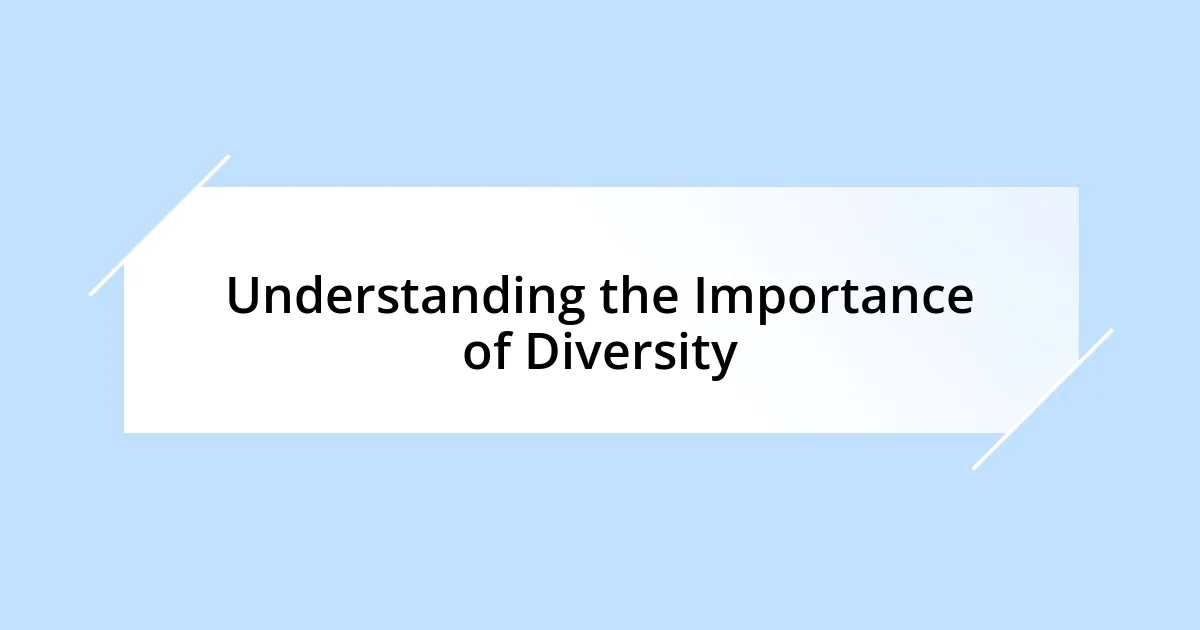
Understanding the Importance of Diversity
Diversity in the classroom is not just about having students from different backgrounds; it’s about enriching the learning experience for all. I recall a moment when a student from a different culture shared a traditional story from their home country. It brought the class together in laughter and curiosity, reminding me how these shared experiences can build bridges and foster empathy among students. Isn’t it fascinating how one story can spark a whole new perspective in the minds of young learners?
As I navigated my teaching journey, I began to see the value in embracing differences. When I introduced activities that celebrated varied cultures, students became more engaged and open-minded. For instance, during a project focused on world festivals, I watched as students collaborated, learned, and respected each other’s traditions. It made me wonder: how often do we overlook these teachable moments that allow students to connect on a deeper level?
Recognizing diversity also prepares students for the real world, where they will work and interact with people from all walks of life. I remember a particular discussion in class about social issues. Students were respectful and listening intently to one another, showcasing their ability to engage in meaningful dialogue. This experience left me with a realization: the skills they learn in a diverse classroom—tolerance, critical thinking, and collaboration—are invaluable for their future interactions in an increasingly interconnected world.
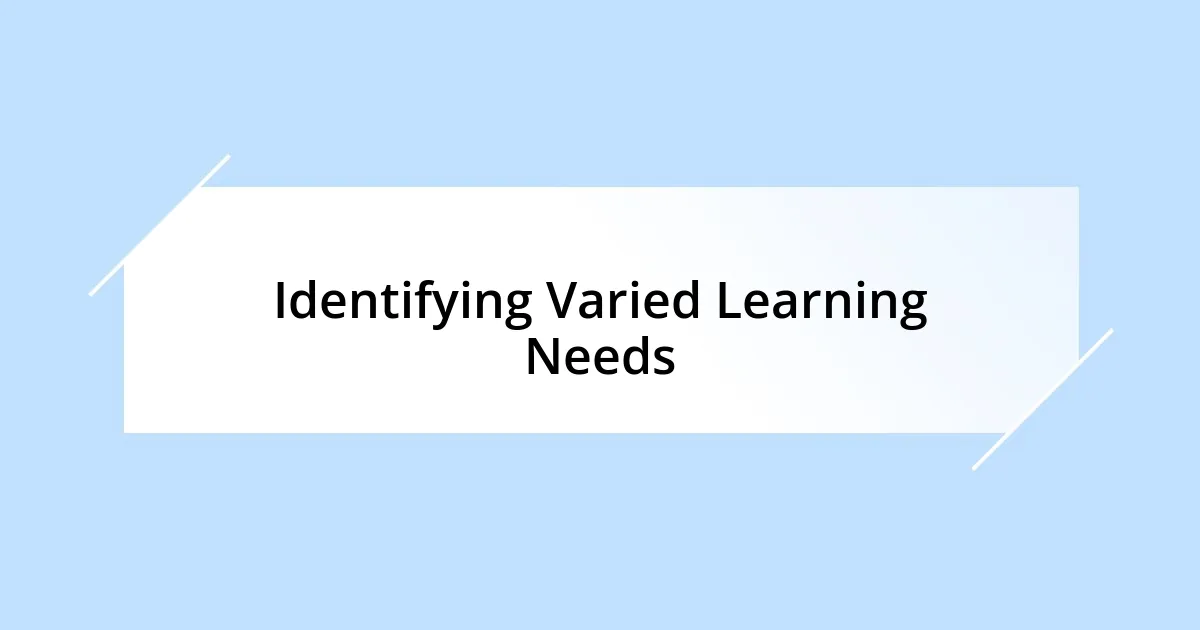
Identifying Varied Learning Needs
Identifying and understanding varied learning needs in the classroom has been one of my essential focuses as an educator. I’ve noticed that no two students learn the same way. For example, while teaching a lesson on math, one student thrived with visual aids, eagerly sketching out problems, while another preferred hands-on activities, using manipulatives to grasp concepts. This taught me that differentiation is crucial; I can’t apply a one-size-fits-all approach if I want to reach every learner.
One time, I implemented group discussions where students expressed their preferred learning styles. Hearing their diverse perspectives opened my eyes to the range of needs present in my class. A student who struggled with verbal communication shared that they absorbed information better through videos and pictures. This simple exchange allowed me to adjust lesson plans to include more visual elements, ultimately enhancing engagement. Isn’t it rewarding when students feel heard and valued for who they are?
Recognizing these varied learning needs doesn’t just enhance academic success; it also fosters a nurturing community. I remember working with a child who had learning differences and often felt isolated. By tailoring my approach to their unique needs and encouraging peer support, I saw a transformation not only in their confidence but also in how their classmates responded. This experience solidified my belief that understanding each student’s learning needs creates a more inclusive and empathetic environment.
| Learning Style | Example Student Behavior |
|---|---|
| Visual Learners | Prefer diagrams and visuals to comprehend concepts. |
| Kinesthetic Learners | Engage better with hands-on activities and movement. |
| Auditory Learners | Thrive in discussions and verbal explanations. |
| Reflective Learners | Benefit from thinking time and individual work. |
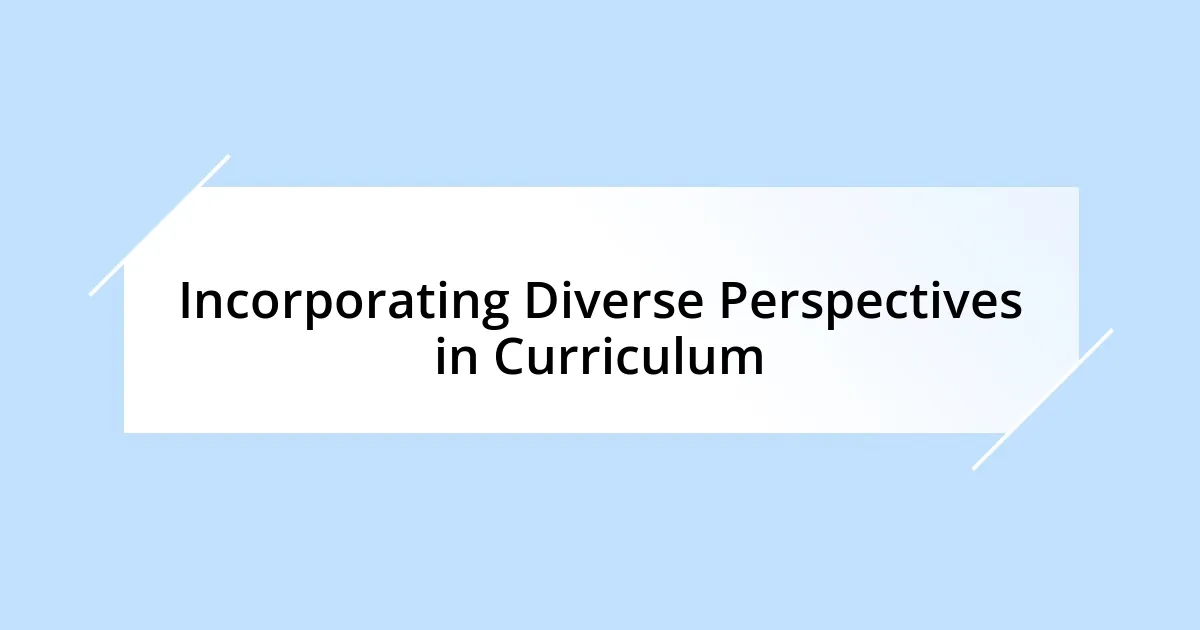
Incorporating Diverse Perspectives in Curriculum
Incorporating diverse perspectives into the curriculum has been a transformative journey for me as an educator. I remember when I decided to include literature that reflected the voices of underrepresented groups. Introducing novels from authors of various backgrounds sparked rich discussions in my class. It was rewarding to watch my students connect with characters whose experiences resonated with them, deepening their understanding of social issues. They often shared personal stories related to the themes, which made each lesson feel like a shared experience rather than mere instruction.
To successfully integrate diverse perspectives, I found it essential to embrace a variety of teaching methods and materials, such as:
- Multicultural Literature: Selecting books that highlight different cultures and viewpoints to encourage empathy.
- Guest Speakers: Inviting community members from varied backgrounds to share their experiences and insights.
- Collaborative Projects: Assigning projects that require students to explore and present on global issues, allowing them to research their chosen culture.
- Media Variety: Utilizing films, documentaries, and podcasts that feature diverse narratives to complement the curriculum.
- Discussion Circles: Creating safe spaces for students to voice their thoughts and feelings on topics of diversity and inclusion.
By weaving in these practices, I noticed my students not only gained knowledge but also developed a greater appreciation for the richness that diversity brings to our world. Each lesson became a chance to celebrate who they are, enhancing their sense of belonging and community in the classroom.
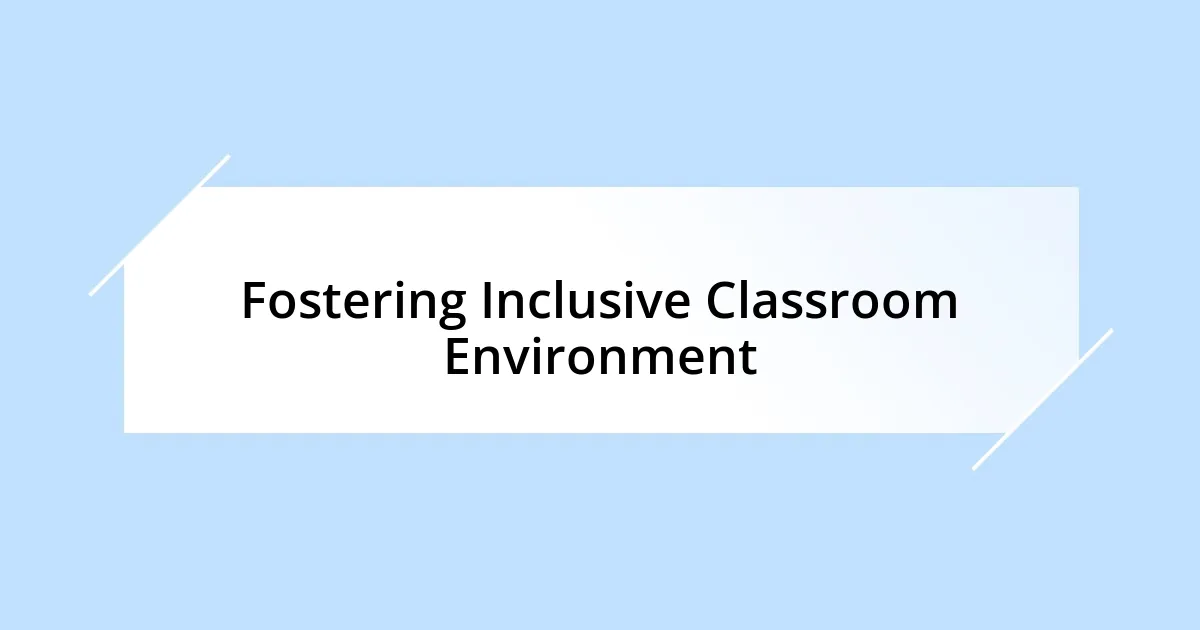
Fostering Inclusive Classroom Environment
Creating an inclusive classroom environment has been a game-changer for me and my students. I recall a moment during a group project where diverse students formed an unexpected partnership. One student, who typically kept to themselves, found common ground with a peer from a different background. Their collaboration not only broke the ice between them but also fostered mutual respect and understanding. Isn’t it amazing how a simple project can lead to newfound friendships and a sense of belonging?
I’ve also learned that language can be a barrier, but it can also become a bridge. When I had an English language learner in my class, we implemented a buddy system, pairing them with students who spoke their home language. The transformation was incredible! The classmates felt empowered, and the bonds they formed helped create a supportive atmosphere where every student felt valued. Can you imagine how much this can enrich the learning experience for everyone involved?
Inclusion goes beyond just academic strategies. I often incorporate moments for sharing personal stories during our morning circle. This practice allows students to connect on a deeper level, truly embracing what each person brings to our classroom. The vulnerability shown in these moments is both inspiring and heartwarming. How often do we make space for these human connections? By fostering an environment where students feel safe to express their authentic selves, I’ve witnessed a ripple effect of kindness and compassion grow throughout our classroom community.
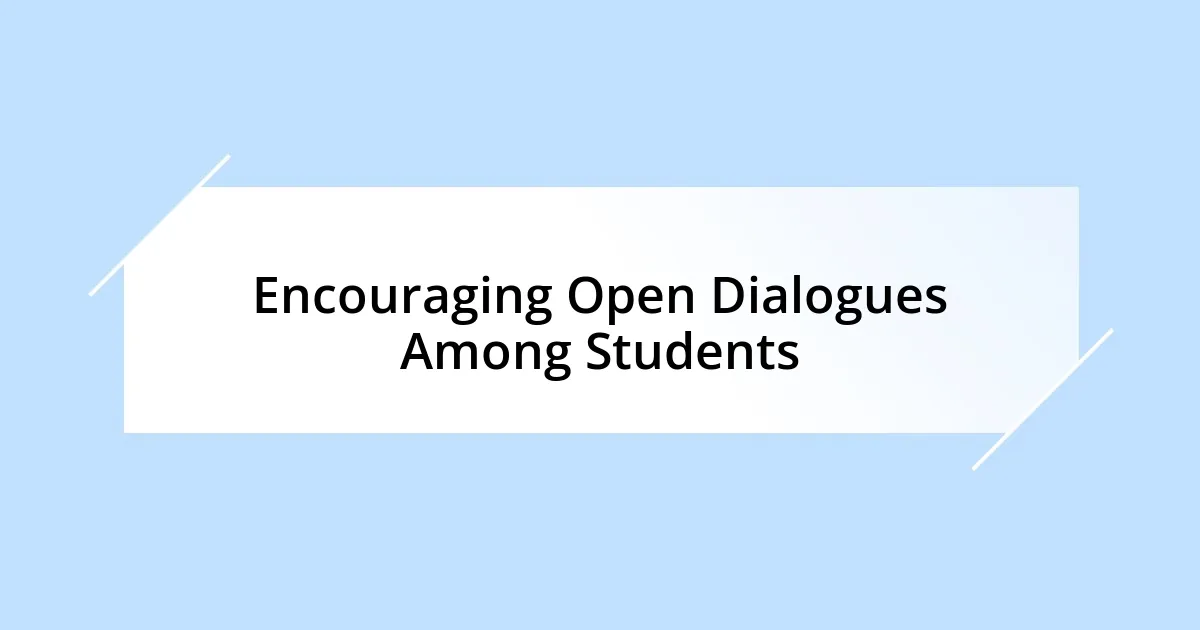
Encouraging Open Dialogues Among Students
Encouraging open dialogues among students is a cornerstone of fostering understanding and respect in the classroom. I recall during a particularly heated discussion about cultural identity, a student opened up about their own experiences with exclusion. The honesty in their voice made the room fall silent, allowing others to reflect on their own experiences with diversity. Isn’t it fascinating how one shared story can unlock a treasure trove of personal truths among peers?
To create an atmosphere where students feel comfortable sharing, I often utilize thought-provoking prompts that challenge them to reflect on their beliefs and experiences. For instance, I posed the question: “What does belonging mean to you?” The responses were varied and deeply personal. Some students spoke about their families, while others discussed the struggles of fitting in. Facilitating these conversations not only nurtures empathy but also ignites a sense of community. Have you ever noticed how openness about vulnerability can inspire others to step out of their comfort zones?
I also found that establishing ground rules for respectful dialogue really empowers students to speak freely. When I introduced guidelines around listening and responding thoughtfully, I saw a shift in how students interacted. Instead of talking over each other, they began to ask clarifying questions and build on one another’s thoughts. This collaboration taught them the value of every voice in the room. It reinforced for me that encouraging such dialogues isn’t just beneficial; it’s essential for cultivating an inclusive and dynamic learning environment.
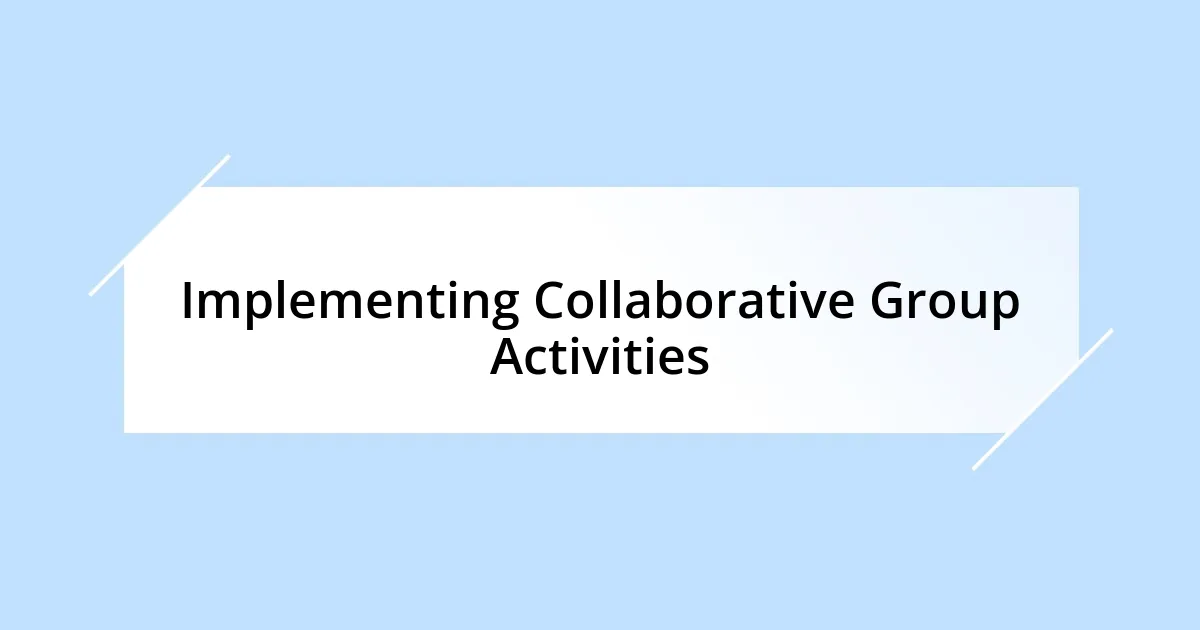
Implementing Collaborative Group Activities
One of the most impactful strategies I’ve implemented is collaborative group activities. I remember the first time I divided my class into mixed ability groups for a science project. Initially, I felt a twinge of nerves – would they work well together? To my surprise, they not only tackled the project creatively but also began sharing insights that I hadn’t anticipated. Watching students who usually kept to themselves engage and contribute was truly special. It made me reflect—how often do we underestimate the potential of collaboration?
In another instance, I assigned a literature circle where students rotated roles as discussion leaders, summarizers, and connectors. It was intriguing to observe how each student brought their unique perspective into the conversation. One quiet student, for example, took on the summarizer role and provided insights that captivated the whole group. It reminded me that everyone has something valuable to share. Isn’t it incredible how diverse perspectives can enrich our understanding of a text?
I have also found that structuring cooperative tasks around shared goals fosters a deeper sense of community. During a math challenge, I noticed how students began to lean on each other’s strengths to solve complex problems. The excitement in the room was palpable, and it was clear that they developed trust in one another during the process. Doesn’t it warm your heart to see friendships blossom through shared challenges? These experiences not only boost their academic skills but also teach invaluable life lessons about collaboration and empathy.
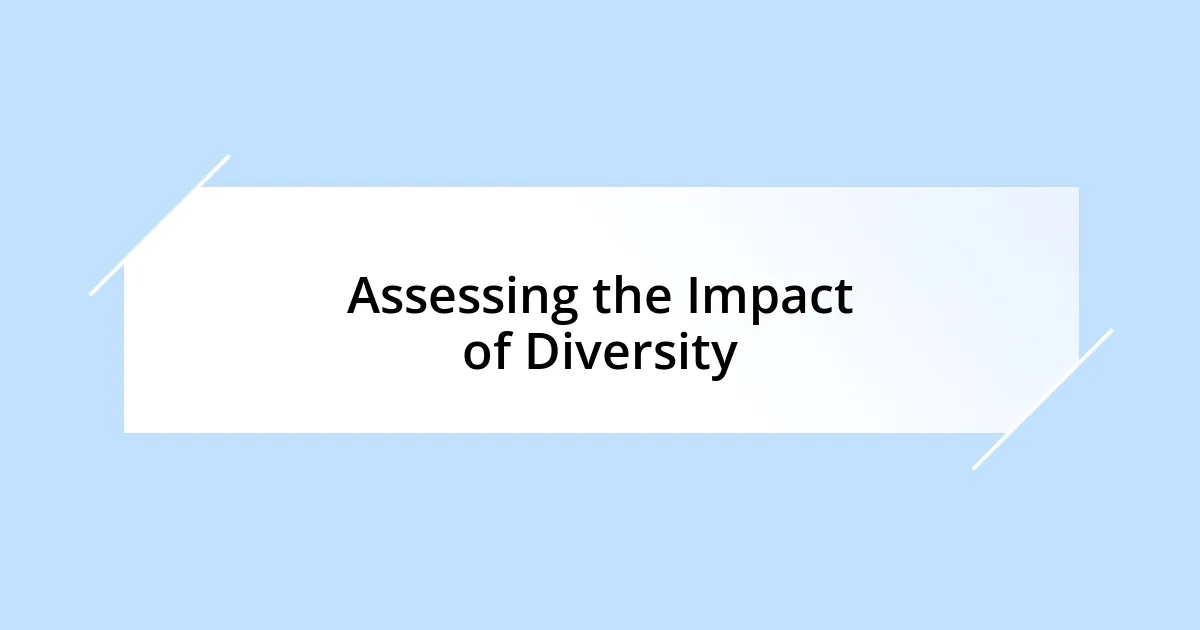
Assessing the Impact of Diversity
Assessing the impact of diversity in the classroom goes far beyond just observing student interactions; it requires a deeper reflection on how these diverse elements shape learning outcomes. I remember conducting a survey at the end of the term, where I asked students to share how their perspectives had shifted due to their interactions with peers from different backgrounds. Their candid responses revealed a profound level of growth—I was genuinely moved by how many expressed newfound appreciation for cultures different from their own. Isn’t it remarkable how learning environments can influence empathy and understanding in ways we often overlook?
One aspect that stood out to me was the enhancement of critical thinking skills. During discussions, I noticed students grappling with contrasting viewpoints, which prompted them to critically assess their beliefs. I recall a heated debate on societal norms, where students were challenged to defend positions different from their own. The level of thoughtfulness and respect they exhibited was inspiring, and it made me think—how often do we allow ourselves to be challenged in our own beliefs?
Additionally, I found that the benefits of diversity manifested in improved student performance as well. When I analyzed test scores and project outcomes, there was a noticeable uptick in students’ achievements. It’s as if the rich tapestry of experiences in the classroom ignited a competitive spirit, urging them to rise to the occasion. But I’d ask you—can academic success truly reflect the full measure of diversity’s impact, or is there something more profound at play? These reflections remind me that embracing diversity is not just an educational strategy; it’s a transformative journey for both students and educators alike.

